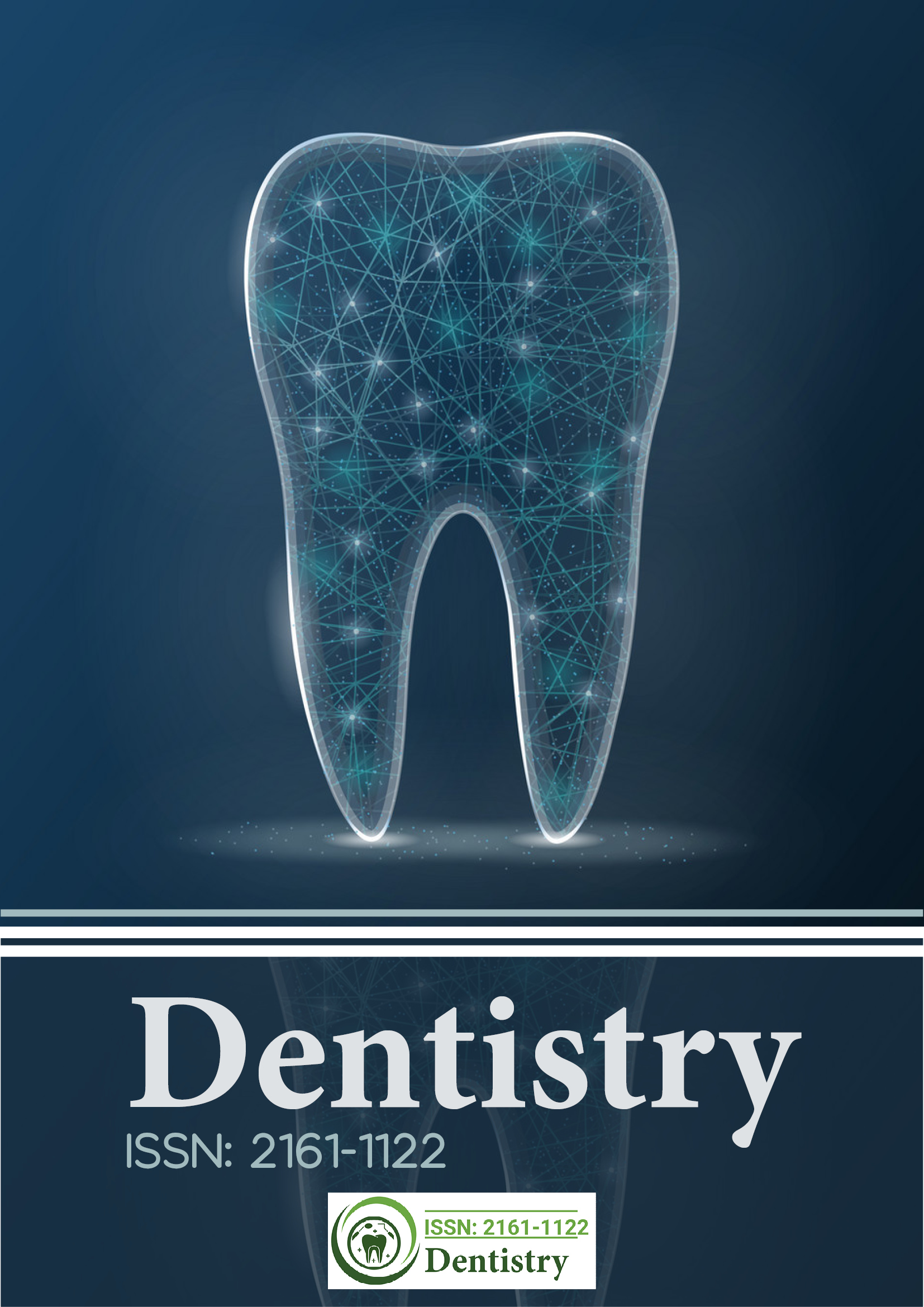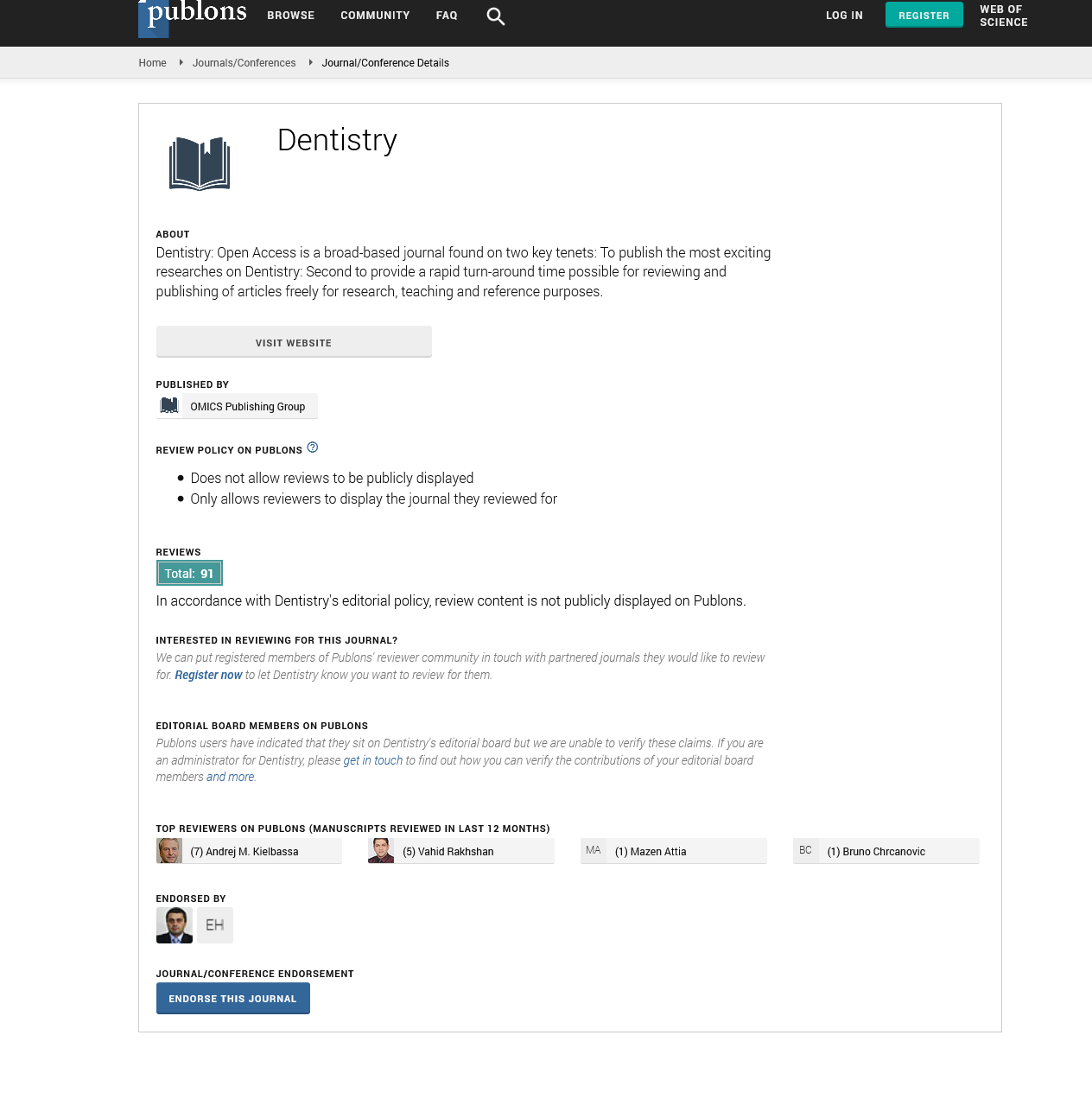Citations : 2345
Dentistry received 2345 citations as per Google Scholar report
Indexed In
- Genamics JournalSeek
- JournalTOCs
- CiteFactor
- Ulrich's Periodicals Directory
- RefSeek
- Hamdard University
- EBSCO A-Z
- Directory of Abstract Indexing for Journals
- OCLC- WorldCat
- Publons
- Geneva Foundation for Medical Education and Research
- Euro Pub
- Google Scholar
Useful Links
Share This Page
Journal Flyer

Open Access Journals
- Agri and Aquaculture
- Biochemistry
- Bioinformatics & Systems Biology
- Business & Management
- Chemistry
- Clinical Sciences
- Engineering
- Food & Nutrition
- General Science
- Genetics & Molecular Biology
- Immunology & Microbiology
- Medical Sciences
- Neuroscience & Psychology
- Nursing & Health Care
- Pharmaceutical Sciences
Commentary - (2024) Volume 14, Issue 2
Importance of Dental Care Procedures for Permanently Strong Teeth
Rong Ling*Received: 03-Jun-2024, Manuscript No. DCR-24-26154; Editor assigned: 05-Jun-2024, Pre QC No. DCR-24-26154; Reviewed: 19-Jun-2024, QC No. DCR-24-26154; Revised: 26-Jun-2024, Manuscript No. DCR-24-26154; Published: 03-Jul-2024, DOI: 10.35248/2161-1122.23.14.684
Description
Dental health is a key aspect of overall well-being that is often overlooked until problems arise. Maintaining permanent strong teeth requires more than just regular brushing, it involves a comprehensive approach that includes various dental care procedures. These procedures not only prevent dental issues but also contribute to a healthy, confident smile that can last a lifetime. It explores the value of dental care practices and how they protect permanent teeth's integrity. Dental care procedures encompass a range of practices and treatments designed to maintain oral health. These include routine cleanings, fluoride treatments, sealants, fillings, root canals, and more advanced procedures like crowns and implants. Each of these plays a specific role in protecting teeth from decay, damage, and disease.
Routine cleanings and dental examinations are the foundation of good oral health. Professional cleanings remove sign and coating that regular brushing and flossing cannot. These cleanings assist in the prevention of gum disease, cavities, and bad breath. Regular examinations allow dentists to detect early signs of dental problems such as cavities, gum disease, and oral cancer, which are easier to treat in their initial stages. Fluoride treatments are particularly beneficial for children, but adults can also benefit from them. These treatments can reverse early signs of tooth decay and help maintain the strength of the enamel. Dentists are able to treat teeth with a concentrated fluoride solution to give them long-lasting protection against cavities.
Dental sealants are a preventive measure used primarily on children’s molars and premolars, but adults can benefit from them as well. Sealants are a thin, protective coating applied to the chewing surfaces of the back teeth, where decay often starts. They act as a barrier against food particles and bacteria, significantly reducing the risk of cavities. Sealants are a simple and effective way to protect teeth, especially in individuals who are prone to tooth decay. Despite best efforts in preventive care, cavities can still occur. When they do, dental fillings are necessary to restore the tooth's function and integrity. Modern fillings can be made from various materials, including composite resin, which can be matched to the natural color of the teeth. Properly done fillings not only restore the tooth but also prevent further decay and damage. When tooth decay progresses to the pulp the innermost part of the tooth it can cause severe pain and infection. A root canal procedure removes the infected pulp, cleans the inside of the tooth, and seals it to prevent further infection. This procedure can save a tooth that would otherwise need to be extracted, preserving the natural alignment and function of the teeth. Crowns are used to cover and protect a damaged tooth, restoring its shape, size, strength, and appearance. They are often recommended after a root canal or for teeth that have been severely damaged by pain.
For teeth that are lost due to decay, injury, or other reasons, dental implants suggest a permanent solution. Once integrated with the bone, they provide a stable base for artificial teeth (crowns). Implants are the closest substitute to natural teeth in terms of strength, stability, and appearance. They also help prevent the bone loss that typically follows tooth loss, maintaining the structure of the jaw. Orthodontic treatments, such as braces and clear aligners, are essential for correcting misaligned teeth and bites. Proper alignment of the teeth not only improves appearance but also enhances oral health. Misaligned teeth can create hard to clean areas, leading to an increased risk of cavities and gum disease. Orthodontic treatments ensure that teeth are in their optimal positions, making them easier to clean and reducing the risk of dental problems. Healthy gums are vital for strong teeth. Dental procedures such as scaling and root planning (deep cleaning) are used to treat gum disease. These procedures remove sign and coating from below the gum line and smooth the root surfaces to promote gum reattachment. Regular dental visits for professional cleanings and monitoring of gum health are essential to prevent gum disease and ensure the longevity of teeth. Preventive dental care is not only about procedures performed by dentists but also about educating patients on proper oral hygiene practices. Dentists play a vital role in teaching patients how to brush and floss effectively, the importance of a balanced diet for oral health.
The efficiency and comfort of dental care procedures have greatly increased due to developments in dental technology. Laser dentistry allows for more precise and less painful treatments. These technological advancements make dental care more efficient, effective, and accessible. Investing in preventive dental care procedures can lead to substantial economic benefits. Preventive care reduces the possibility of developing severe dental problems that require expensive treatments. Regular dental visits and timely interventions can save patients from costly procedures such as extractions, root canals, and implants. The importance of dental care procedures for maintaining permanent strong teeth cannot be overstated. From routine cleanings and fluoride treatments to advanced procedures like implants and orthodontics, these practices play a vital role in preserving oral health. Healthy teeth contribute to overall well-being, enhancing both physical and emotional health.
Citation: Ling R (2024) Importance of Dental Care Procedures for Permanently Strong Teeth. J Dentistry. 14:684.
Copyright: © 2024 Ling R. This is an open access article distributed under the terms of the Creative Commons Attribution License, which permits unrestricted use, distribution, and reproduction in any medium, provided the original author and source are credited.

